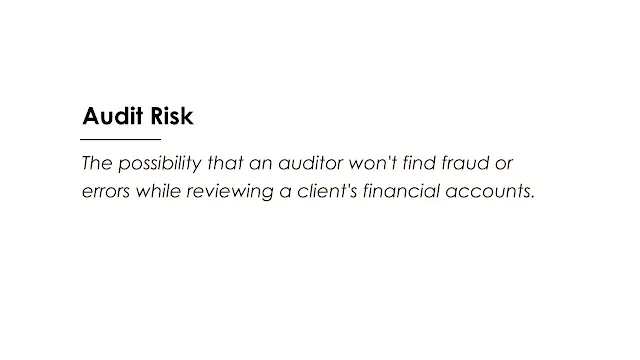 |
| Image: Moneybestpal.com |
Audit risk is the possibility that an auditor won't find fraud or errors while reviewing a client's financial accounts. A certified public accounting (CPA) firm providing audit services may be legally liable for audit risk. In order to lower the amount of audit risk, auditors can increase the number of audit procedures.
Since readers of financial statements rely on the auditors' guarantees when they read an organization's financial statements, reducing audit risk to a manageable level is an important part of the audit function.
- Control risk is the possibility that a client's control systems won't be able to identify or stop a potential substantial misstatement. For instance, there is a higher possibility that errors or fraud will occur and go unnoticed if a client does not have sufficient segregation of roles, permission procedures, or reconciliation processes.
- Detection risk is the risk that the audit procedures used are not capable of detecting a material misstatement. For instance, there is a higher possibility that errors or fraud will go unnoticed if an auditor fails to choose a representative sample, employ suitable analytical procedures, or confirm the information's source.
- Inherent risk is the risk that a client's financial statements are susceptible to material misstatements. There is a greater possibility that mistakes or fraud will occur and have an impact on the financial statements if a client, for instance, engages in considerable business with related parties, works in a complicated or dynamic industry, or makes estimates and judgments in accounting.
Audit risk can be expressed by the following formula:
Audit Risk = Control Risk x Detection Risk x Inherent Risk
According to the formula, audit risk can be decreased by reducing any one of its three components. The trade-off between detection risk and the other two factors exists, though. Auditors must carry out more thorough and rigorous audit processes to lower detection risk if control risk and inherent risk are high. In contrast, auditors can accept a higher detection risk and carry out less thorough and rigorous audit processes if control risk and inherent risk are minimal.
Let's look at an example to show how audit risk functions. Consider that an auditor is checking the sporting goods store's inventory balance. The auditor assesses the following levels of risk for each component of audit risk:
- Control risk: High. The client lacks efficient internal controls for inventory management, including cycle counts, ongoing physical counts, and perpetual inventory records.
- Detection risk: Low. A thorough physical inventory count will be conducted by the auditor, and the results will be compared to the accounting records. Using a variety of analytical methods and source materials, the auditor also intends to check the valuation, presence, and completeness of the inventory.
- Inherent risk: Moderate. The client's business is seasonal and in a cutthroat market, which could have an impact on inventory demand and price. A few inventory items owned by the client are likewise vulnerable to deterioration or obsolescence.
Using the formula, we can calculate the audit risk as follows:
Audit Risk = High x Low x Moderate
Audit Risk = Moderate
The auditor comes to the conclusion that the audit risk is acceptable for delivering an unqualified opinion on the financial statements because it is at a modest level. However, the auditor might need to modify the audit methods if any of the audit risk components change.
The inherent risk might be increased, for instance, if the auditor learns that the client has extensive inventory transfer transactions with connected parties. In that instance, the auditor might need to carry out additional procedures to confirm the nature, terms, and disclosure of the transactions in order to lower the detection risk.
In contrast, the control risk may be reduced if the auditor learns that the client has adopted new internal controls for inventory management, such as barcode scanning, automated inventory tracking, or independent inventory audits. The auditor might therefore be able to raise the detection risk by putting the inventory balance under less rigorous or broad scrutiny.
The concept of audit risk is crucial because it has an impact on the accuracy and dependability of the audit opinion. By using professional judgment and skepticism, gathering sufficient and pertinent audit evidence, and correctly documenting their work, auditors must assess and manage audit risk throughout the audit process.
